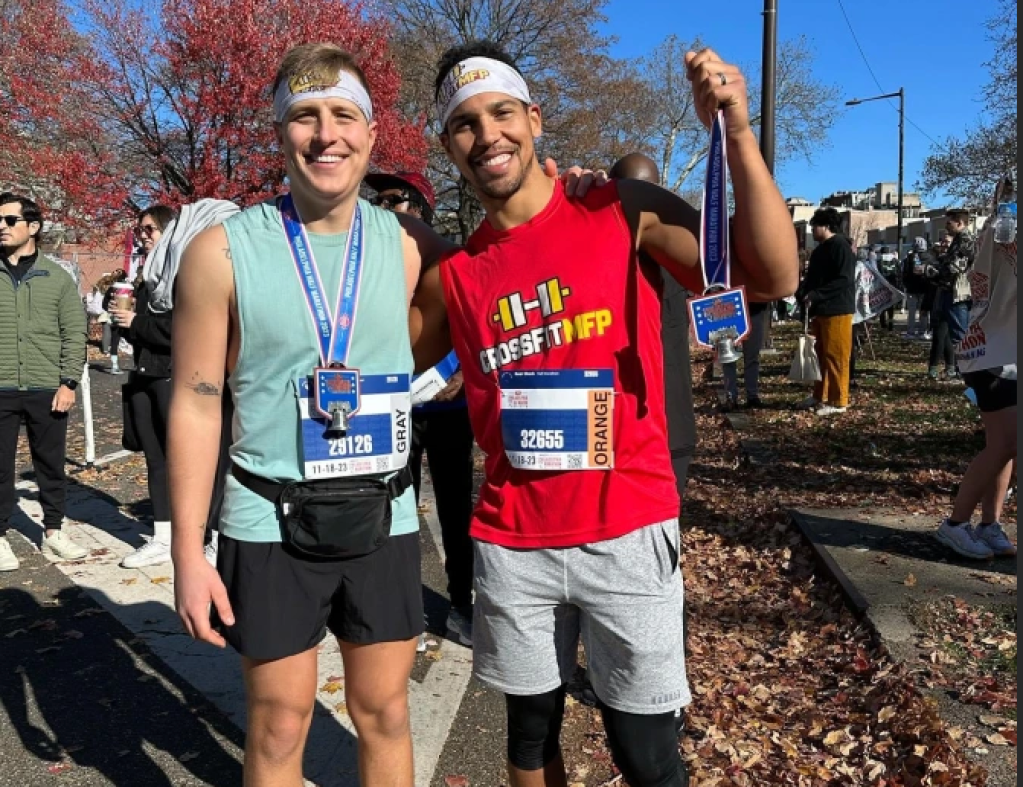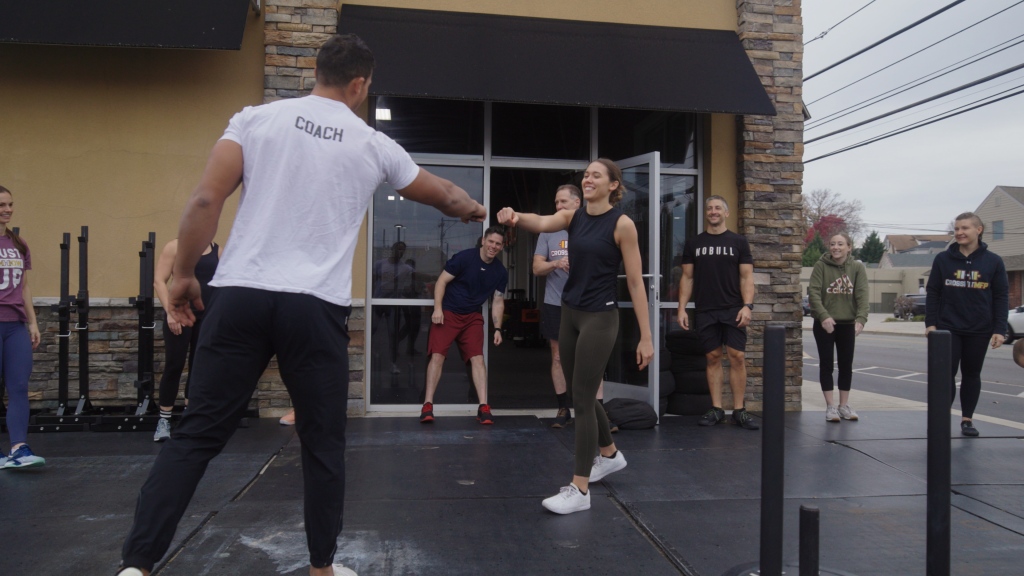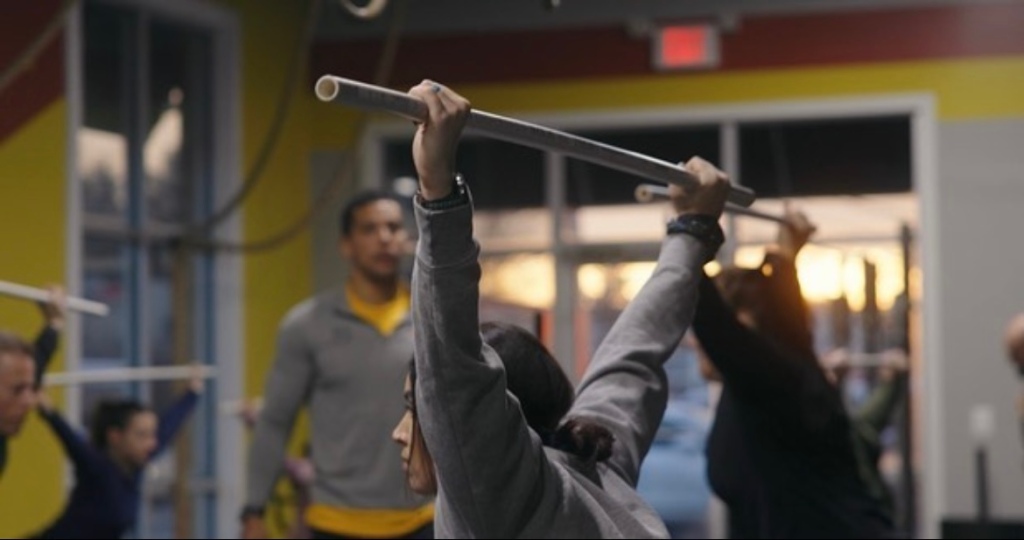Foreword by Joe Yamulla

Members of the MFP community have been asking me… “why did you start a run club?”
Before I give you the answer, I’ll tell you this. First and foremost, I am not an experienced nor a strong runner. Distance running has never been my strength nor something I have particularly enjoyed. In fact, like plenty of others in the CrossFit community, I actively disliked running for many years.
However, as I’ve grown over the years, I’ve spent quite a lot of time thinking about what it truly means to be fit. Specifically, what does it mean to be fit for life and longevity? To me, it means being equipped to take on whatever physical, mental, or emotional tasks life throws at us. It means being capable of showing up and expressing ourselves in any situation. We might excel in some areas, and some others might demand us to persevere through adversity. Whatever the case may be, we just show up and conquer the task at hand.
No matter who you are, where you live, or your environmental circumstances, you can run in some capacity. It is remarkably accessible. You can run at any speed. You can move your body forward from one point to another – even if it is in an adaptive manner. I came to realize that what I disliked about running for all these years is actually what makes it such a wonderful, physical practice.
It’s the simplest form of human monostructural capacity. You are using your two feet to traverse through varied environments and venture forward towards your goal. The physical demand is substantial – and that’s what makes it powerful. There is beauty in the grind – pushing your limits and truly moving forward one step at a time. In the moments we feel struggle, we’re actually undergoing physical transformation and growth.
As I pushed myself on consistent runs, I found that it is equally as powerful as an emotional and spiritual practice. As you run, there is nothing to think about. It’s just you, your feet, and nature surrounding you. Allow this physical practice to turn into a mindfulness practice. Notice thoughts, feelings, and emotions that come up and let them flutter by – just like the physical world that you are passing by. You’ll discover a remarkable state that enhances your physical, mental, emotional, and spiritual wellbeing. In a way, it is meditation with constant movement.
It’s just you – simply being and moving. And that, I have found to be quite special. That is why I started running. That is why I started the MFP Run Club. And of course, that is how I encouraged my good friend Marco to start his own running journey with me. The group process makes running so much more effective, motivating, and inspiring. In the first few months of this adventure, we have traversed many miles, achieved meaningful feats (like the barefoot half marathon), and best of all – have got to spend meaningful time together. I am very grateful to run together, be together, and grow together.

I was not “Born to Run…”
Athletically, I would be categorized as a “power” based athlete. This is because my sports during my youth were football, basketball, baseball, and 400-meter track events. A common theme with these activities is that they all required me to use a very specific energy system when I ran. I was developed to run fast, within a short burst, or for a short time.
Fast forward to post-high school sports and living a yogi lifestyle in college. When I was introduced to CrossFit, I was drawn to the variance of fitness skills developed with a method. I was learning about the beauty of metabolic conditioning. This method of developing energy systems integrates all domains, skills, and components of fitness (see functional fitness article). One domain that is quite important, and many times underutilized, is the oxidative, aka aerobic, energy system. This is because typically, CrossFit “metcons” are consistent within the general minimum of 10 minutes to the general maximum of 20 minutes. Metcons typically demand higher intensity, zones, or training. Although metcons have numerous benefits physiologically, balance one’s overall work capacity, and are accessible for 1-hour-long group classes, the time domains for 30+ minutes are rare to see within CrossFit affiliates.
*Note: On Saturdays at MFP our target time domains are 25-45 Minutes depending on our phase of programming, and to balance our energy systems developed Monday through Friday. These Saturday workouts are typically mixed modal, meaning they integrate gymnastics, weightlifting, and mono-structural elements

Circa 2014, my early CrossFit years. I would much rather push a heavy sled in short distance…
Where does Running apply to CrossFit?
About Monostructural Elements: These movements play a vital role in the CrossFit methodology. Monostructural movement patterns are typically cyclical and performed over an extended time. This means that they have the most efficient process to work within the aerobic energy system, or lower zones, of development. By intently incorporating monostructural movements within a fitness program, you support your whole being of physical abilities. The most common examples include:
- Biking (Road Bike, Air Bike, or Ergometer)
- Rowing (Ergometer)
- Ski-Ing (Ergometer)
- Jumping and Landing (high volume, low impact such as jump rope)
- Swimming
- And the most popular of all…Running
*fun fact: Running is the most programmed element within the CrossFit main site (beginning circa 2000). The #1 workout programmed is a 5k Run. And why not?! It is the most accessible (for most), and “functional” form of human movement. Also, a 5k just about fits within a “long” distance for running, but can also be completed at a higher intensity pace as well to make it less aerobic. As sprinting is superior for anaerobic/power development (see power article), long-distance running is superior for aerobic/cardiovascular development.
Back to the Basics, Running is Hard!
With that said, long-distance running and sprinting are not basic by any means and require a significant amount of mindfulness and development. The details within gait patterns, breathwork, cadence/pacing, contralateral reciprocation, and much more that are required to be efficient, effective, and safe. More importantly, these details are essential for the true longevity of being a land animal.
I have had practical experience with clientele over the previous 12 years who seek to improve their running performance, specifically long distances. In a majority of these cases, their goal is to use CrossFit as a tool to balance their training through the protocols of variance. In many cases, their lungs and heart can sustain the tasks, but their strength, power, and mobility are usually lacking. Other than improving their performance as a whole, many times I have helped restore imbalances from high volumes of single-leg impact and poor tendencies.
As for implementing long-distance running to balance my overall CrossFit abilities, I was lacking consistency in applying myself. A truly balanced CrossFit program incorporates endurance/aerobic-based protocols. Sure, I am mentally and physically capable of completing longer tasks, but not as efficiently or as effectively as I could have. The first reason is that it is time-consuming, the second is that longer time domains are a weakness, and the third is that I would get bored completing longer based tasks, and did not enjoy the process. These, however, are all excuses, as I have been humbled by my clear gap of endurance abilities. I have completed a handful of CrossFit competitions and fitness based events with longer time domains, some include:

2018 CrossFit Regionals: Row 3k, 300 Double Unders, Run 5k (about 40 minute event)

2019 Row a Marathon: About 3 Hours

2023: A mini triathlon with an 11k Bike and 4k run, and poor attempt at a 400m swim

and too many 5ks…
Now all of these endurance-based tasks could have been much easier if I put more time and effort into my aerobic development as I have with my other components of fitness. All of my results were subpar, as expected. A poor perspective and lack of resources limited me from improving in all areas of my fitness, and life. It was finally time to practice what I preached. It was about saying yes to trying something new and putting my body, mind, and spirit up to new opportunities.
Why do a Half Marathon…Barefoot?
Before the date of October 30th, 2023, the idea of doing a half marathon in 3 weeks was not in my plans. A fellow friend, and MFP Educator-creator, Joe Yamulla, invited me to join him on the task of completing one. As he was already a few weeks into preparing, I was not fully into the idea of committing. However, 2023 has been a year of self-discovery for me. Thanks to experiences with psychedelics, mindfulness, and spirituality, I have learned to be more curious, and more open-minded in trying new things.
Joe is also a loyal follower of my methods and philosophies, one particularly being a barefoot shoe advocate. Part of his pitch was to put my years of being barefoot to the test. In addition, could I complete this task with minimal (running) training, and relying on my fitness and resiliency developed from CrossFit? For me, balance within my fitness is important, and this could be the perfect opportunity for me to improve on this long-term weakness of aerobic development. Lastly, I created a few initial goals:
Pre Half Experience
- Commit to the Barefoot Experience: For many runners, this concept doesn’t make sense. Yes, no cushion on miles of concrete is not achievable or sustainable for a majority of the population. However, I have not worn any shoes other than a barefoot shoe for over 2 years. This is a great opportunity to see if my feet, ankles, knees, hips, and back have improved my overall resiliency.
- Preparation: Participate in 3 running sessions with Joe within 2 weeks. 5 Miles, 6 Miles, and 10 Miles. To see if I could physically handle higher doses of running volume on the good ole dawgs.
- Daily CrossFit: The MFP program supports developing your fitness so that you can complete any physical task that you wish to endeavor. So why be fit if I can’t apply it? CrossFit would also support my overall work capacity, mobility, and joint health.
- No Biofeedback: We have wonderful tools known as breathwork and mindfulness. My experiment requires no technology to tell me heart rate, pace, or time. This includes the preparation runs and the half marathon itself.
Pre, During and Post Experience Findings
Finding Flow States: The beautiful challenge of endurance-based events is that you have no choice but to be in your mind for an extended time. Quite honestly, this concept has similarities to experiencing breathwork and psychedelics. It is a similar opportunity to spend valuable time in your psyche doing inner work. In addition to entering an altered state of consciousness (via runners high), some amazing things can be accomplished through your thought processes during an endurance event, especially when you are mindful of that benefit.
Applying Mindfulness: In addition to being in your thoughts, you can apply the practices of mindfulness. You are going through consistent external and internal stimuli for 1-2 hours. The value of being present and consciously aware of these stimuli not only empowers your ability to explore consciousness, while also allowing the running process to be quite frankly…less boring! Some general things I become more aware of are:
- The Mechanics of Running: While being barefoot, I found value in thinking about every stride. Especially when processing the weight distribution of the foot and the efficiency of leg movement. I would practice being aware of my torso, posture, and other important mechanics. More importantly, it is about sustaining those mechanics!
- Breathwork: If I could breathe in and out only through the nose, I was within a sustainable pace. I would notice what circumstances changed my breathing patterns, and how to regulate my breath during specific times of the race. Along with a personally-made music playlist, my breath would sometimes be used as a tool to assist with my rhythm and cadence.
- Embracing your Surroundings: Other than making sure you don’t trip over something, many times you are mindful of what is only in front of you. When you encounter nature, and an environment with a large crowd of supporters, you can take in a variety of positive inputs that exceed your linear path.
- Physiological Changes: These long periods of consistent exercise create consistent changes in your internal processes. One is a potential potty break, especially if you’re running for 2 hours. If anything will catch your awareness, it will be the resistance to going number 1 or 2 in your pants. I can officially say that I can relate to the category of individuals who end up adding a few minutes to their time due to a porta poo session. I decided not to suffer, so I could come back to bringing my present moment to more meaningful things.
- Time and Space: Without the use of technology, I had no practical understanding of how long (time and distance) I had been running. It was intriguing to use mindfulness as a way to understand where I was within my runs just because of my intuition from the few preparation sessions.
- Finding Gratitude: Endurance fatigue is very real. I have completed brutal CrossFit workouts in my life, however this is a different source of challenge. Being aware of the adversity became a process of learning how to mindfully process this energy into gratitude. This was not easy, especially as I was struggling during the final few miles of the half!
Music Moves: Personally, applying music has by far been an essential piece to long-distance running. This concept makes obvious sense to most, as it can benefit the points noted above. If you are curious about my music choices, I would be happy to share. I would give you a hint that my music choices are non-traditional 😉 With this said, I would be willing to attempt the challenge of a no-music half marathon, as this could only benefit my mindfulness activities.
Achievement and Empowerment: Positive vibes are always attained when we accomplish a task, especially one with difficulty. Completing any form of sustained exercise leads to confidence and motivation. After finishing the half marathon, I simply wanted to lay on the grass, sprawl out my body, and enjoy the accomplishment, and discomfort.

Conclusion: My #GiftsForGrowth
Coming to Balance: This recent Journey of exploring endurance has opened my perspective to the infinite possibilities of improving our whole being. Not only can I use running as a tool to balance my overall fitness and capacity, but more importantly to strengthen my mind and my spirit. I can find value within my experiences that surpass just the physical benefits!
The Race of Runners: The running community is by far one of the most intriguing groups of individuals. It is diverse and VAST. It was wild to see so many people gather for an event, and so many porta potties to be used! Joining a tribe of runners can be powerful for accountability, motivation, and sustainability for one’s progress in endurance endeavors!
Run to Live: From a biological and physiological perspective, it is important to make sure you are improving your body, mind, and spirit as a whole if you wish to sustain endurance running, or any routine for that matter. Finding a strength/prehab program can have value, as well as making sure that you are training power. Finding balance in all areas of your fitness, and life can play a vital role in your sustained running journey.
Mindful Intuition of Performance Indicators (MIPI): I will continue my running journey without using forms of technology for anything other than developing a running route. As I know there is much value to monitors and trackers, I prefer my mind’s ability to regulate and observe my experience!
Barefoot Boom: After completing a half marathon in my barefoot shoes, I will continue to challenge myself to run without a cushion. As many runners may find my decision blasphemous, I have only seen benefit from the experience, minus the extreme “tenderoniness” after the half. I do admit that I would not be able to sustain a longer distance past 13.1, as I did reach my threshold in my tendons/ligaments/joints within my feet, but also the muscular stamina needed to go further. Theoretically speaking if I were to do 26.2.
What’s Next?: MFP officially has a weekly run club to encourage my local community to find ways to explore their running process. This is also providing me accountability, and purpose to work towards another endurance task and seek new and improved abilities. I signed up for another upcoming barefoot half marathon (Philly Love run in March), and MAYBE train for a barefoot marathon in the fall.
How Can You Start?: Remember, just as with any fitness journey, you do not have to be trained to start! What is important is that you find a tribe that can allow you to begin a process, and provide a sustainable and fulfilling path.

Having a Coach helps! Thank you to Coach Rachel helping me to prepare for the 2017 CrossFit Regionals.






Leave a comment